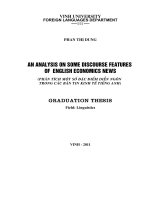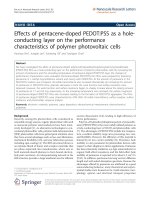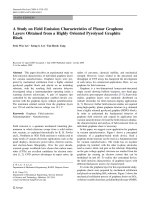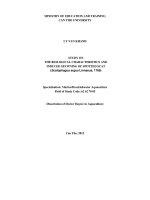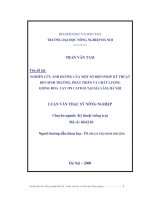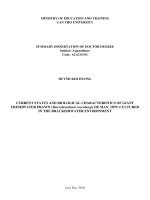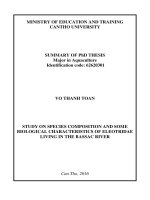Studying on some biological characteristics of tetragonula irdipennis and tetragonula fuscobalteata cameron 1908 (apidae melipona) in gia lam, hà noi 2020
Bạn đang xem bản rút gọn của tài liệu. Xem và tải ngay bản đầy đủ của tài liệu tại đây (2.2 MB, 76 trang )
VIETNAM NATIONAL UNIVERSITY OF AGRICUTURE
FACULTY OF AGRONOMY
UNDERGRADUATE THESIS
TITLE:
“STUDYING ON SOME BIOLOGICAL
CHARACTERISTICS OF TETRAGONULA IRIDIPENNIS
AND TETRAGONULA FUSCOBALTEATA CAMERON 1908
(APIDAE: MELIPONA) IN GIA LAM, HANOI 2020”
Student
: Le Thanh Luong
Code
: 611619
Class
: K61KHCTT
Supervisor
: Assoc. Prof. Dr. Pham Hong Thai
Hanoi,2021
ii
COMMITMENT
I pledge that the contents of this report are honestly conducted by me
under the guidance of Assoc. Prof. Dr. Pham Hong Thai.
I hereby undertake that all references in this document are quoted which
are the name of the authors, name of researches, time, location, and orgins.
I take full responsibility for the report.
Hanoi, March 3, 2021
Student
Le Thanh Luong
i
ACKNOWLEDGEMENT
In order to complete the graduation thesis, in addition to my own efforts, I
have received the enthusiastic help and guidance from teachers, and the care of
family and friends.
First of all, I would like to express my sincere gratitude to Assoc. Prof.
Dr. Pham Hong Thai, Department of Entomology, Vietnam National
University of Agriculture directly instructed me wholeheartedly and helped me
in the process of completing and completing the thesis.
I would like to express my sincere thanks to all the teachers of the
Department of Insect, Agronomy of Faculty, Vietnam National University of
Agriculture for their interest, creating the best conditions for me to implement
the topic.
I would like to express my sincere thanks to all starch of Research Center
for Tropical Bees and Beekeeping, Vietnam National University of Agriculture
directly helped and supported me in the thesis.
Finally, I would like to thank my family and friends who have always
supported and encouraged me throughout the learning and implementation
process.
ii
ABLES OF CONTENT
COMMITMENT....................................................................................................i
ACKNOWLEDGEMENT....................................................................................ii
ABLES OF CONTENT.......................................................................................iii
LIST OF TABLE...................................................................................................v
LIST OF FIGURE................................................................................................vi
ACRONYMS.....................................................................................................viii
ABSTRACT.........................................................................................................ix
PART I: INTRODUCTION..................................................................................1
1.1.
General information..................................................................................1
1.2.
Objectives and Requirements....................................................................2
1.2.1. Objectives..................................................................................................2
1.2.2. Requirements.............................................................................................2
PART II: LITERATURE REVIEW......................................................................3
2.1.
Taxonomy.................................................................................................3
2.1.1. Taxomony.................................................................................................3
2.1.2. Stingless bee species recorded in Asia......................................................4
2.2.
Biological characteristics of stingless bees...............................................9
2.2.1. Caste of stingless bees on colony..............................................................9
2.2.2. Life cycle.................................................................................................11
2.2.3. Behaviors.................................................................................................11
PART III: MATERIALS AND METHODS.......................................................19
3.1.
Objects and materials..............................................................................19
3.1.1. Objects.....................................................................................................19
3.1.2. Materials..................................................................................................19
3.1.3. Time and research location.....................................................................19
3.2.
Research Contents...................................................................................19
iii
3.3.
Methodology...........................................................................................20
3.3.1. Identifying and preserving stingless bee specimens...............................20
3.3.2. Studying on some biological characteristics of T. iridipennis and T.
fuscobalteata...........................................................................................21
PART IV: RESULTS AND DISCUSSION........................................................24
4.1.
Diversity of stingless bee species in Vietnam.........................................24
4.1.1. Number of Subgenera and Species in some provinces in Vietnam:.......24
4.1.2. Morphological characteristics for identification stingless bee species
in experimental locations:.......................................................................26
4.2.
Biological characteristics of T. iridipennis Smith 1854 and T.
fuscobalteata Cameron 1908...................................................................36
4.2.1. Worker brood cells..................................................................................36
4.2.2. Oviposition behaviors.............................................................................38
PART V: CONCLUSION AND RECOMMENDATION..................................50
5.1. Conclusions..................................................................................................50
5.2. Recommendation..........................................................................................51
REFERENCES....................................................................................................52
APPENDIX.........................................................................................................56
iv
LIST OF TABLE
Table 4.1. Composition of stingless bee species in four provinces in
Vietnam, 2020.........................................................................................24
Table 4.2. Subgenera of stingless bee species were found..................................25
Table 4.3. Worker cell dimensions......................................................................36
Table 4.4.Cell capacity and Brood-food volume of worker brood-food.............37
Table 4.5. Ratio of brood-food............................................................................38
Table 4.6. The average hour of cell-building by workers...................................39
Table 4.7. The average of food-discharge duration of workers (seconds)..........43
Table 4.8. The average number of workers who inserted during provisioning
phase........................................................................................................44
Table 4.9. Inserted duration of the ten first workers...........................................44
Table 4.10. Egg-laying duration of queen (seconds)...........................................46
Table 4.11. Egg Dimension.................................................................................47
Table 4. 12. Operculation time (minutes) and number of workers
operculated..............................................................................................49
v
LIST OF FIGURE
Figure 4.1. Mesoscutum of specimen..................................................................27
Figure 4.2. Frontal face of specimen
...............................................................27
Figure 4.3. Hamuli in wing of specimen.............................................................27
Figure 4.4. Frontal face of specimen...................................................................28
Figure 4.5. Bare spot in propodeum of specimen................................................28
Figure 4.6. Mesoscutum of specimen..................................................................29
Figure 4.7. Hamuli in wing of specimen.............................................................29
Figure 4.8. Mesoscutum of specimen..................................................................30
Figure 4.9. Hair arrangement on mesoscutum of T. iridipennis (Sakagami, 1978)
.............................................................................................................................30
Figure 4.10.Frontal face of specimen..................................................................30
Figure 4.11. Hamuli in wing of specimen...........................................................30
Figure 4. 12. Mesoscutum of specimen...............................................................32
Figure 4. 13. Metasomal tergum 1 in Lepidotrigona ventralis, Sakagami 1975. 32
Figure 4.14.Hamuli in wing of specimen............................................................32
Figure 4.15.Fontal face of specimen...................................................................32
Figure 4. 16. Frontal face and forewing of specimen..........................................33
Figure 4. 17. Hindleg of specimen......................................................................33
Figure 4. 18. Mesoscutum of specimen...............................................................33
Figure 4. 19. Lateral view of specimen...............................................................33
Figure 4.21.Frontal face of specimen..................................................................34
Figure 4.20. Facial view and Forewing major veins of Lisotrigona carpenter
Engel (Engel et al, 2018).....................................................................................34
Figure 4.22. Frontal face of specimen.................................................................35
Figure 4.23. Frontal face Homotrigona fimbriata by Siti et al............................35
Figure 4.27. Mesoscutum of specimen................................................................35
vi
Figure 4.26. Lateral view of specimen................................................................35
Figure 4.25. Abdomen of specimen....................................................................35
Figure 4.24. Hamuli of specimen........................................................................35
Figure 4.28. The mean height of growing cell related to that of egg-containing
cell.......................................................................................................................40
Figure 4.29. The number of cells which were building at started stage..............41
Figure 4.30. The percentage of cell building stage at 4 am.................................42
Figure 4.31. Inserted duration of the ten first workers........................................45
Figure 4.32. 1-day-old egg..................................................................................47
vii
ACRONYMS
RCTB
: Research Center for Tropical Bees and Beekeeping
DVE
: Digital Video Eyepiece
viii
ABSTRACT
This study aimed evaluate some biological characteristics of Tetragonula
iridipennis and Tetragonula fuscobalteata in Vietnam in order to maintain bee
diversity and conservation; as well as to apply them in pollination on greenhouse
and identifying some stingless bee species based on morphological
characteristics. Experiments used the camera connected to computer to monitor
throughout the course. There are nine species with six subgenera of one genus
were identified: Homotrigona fimbriata Smith 1857, Lepidotrigona ventralis
Smith 1857, Lisotrigona carpenter Engel 2000, Tetragonula fuscobalteata
Cameron 1908, Tetragonula iridipennis Smith 1854, Tetragonula laviecep
Smith 1857, Tetrigonilla collina Smith 185, Tetrigona apicalis Smith 1857,
Lepidotrigona terminate Smith 1878. There is one unknown species, it belongs
to sub genus Tetragonula. The worker brood cell dimension and cell volume of
T. iridipennis and T. fuscobalteata are significantly different. It was determined:
3.07mm x 2.89 mm with volume 23.87 µL and 2.86mm x 2.67 mm with volume
16.25 µL with T. fuscobalteata. The worker brood food volume of T. iridipennis
and T. fuscobalteata gain 52.43 percent and 62.11 percent of brood cell capacity,
respectively. The worker cell building duration of T. iridipennis was 10.33 hours
and T. fuscobalteata was 7.13 hours in single cell and the type of cell building is
Successive (Sc) The worker food-discharged duration mean of T. iridipennis
Smith was 90.77 seconds at single cell, with the number of workers who
inserted is 29.87. And T. iridipennis Cameron was 94.07 seconds at single cell,
with the number of workers who inserted is 24.03 The provisioning type was
Semi-synchronous (Dm). The egg-laying duration of T. iridipennis and T.
fuscobalteata queens were 2.16 seconds per one cell, with egg dimension 0.92
mm x 0.37 mm and 1.53 seconds per one cell, with egg dimension 0.57 mm x
0.24 mm, in that order. The capping duration of T. iridipennis and T.
fuscobalteata in single cell were 23.86 minutes and 5.15 minutes, with the total
ix
of operculators are 1 to 4 workers and 1 to 2 worker, respectively. The total
number of cells that were provided eggs often lower that number of cells which
were built completely.
x
PART I: INTRODUCTION
1.1. General information
Pollination is an essential ecosystem service that leads to the increase in
food security and improvement of livelihoods. Many animals including bees are
the main pollinators providing that service. Nowadays, it is no denying that bees
take an important in on pollination, making well interaction with cropecosystem, especially stingless bees (Kwangpong, 2010). Slaa et al. (2006)
condensed that stingless bees are effectiveness pollinators in large number of
crops. For instance, Trigona terminata is the most efficient stingless bee
pollinator on coffee trees (Coffea arabica and Coffea canephora). Additionally,
products quality of crops what pollinated by stingless bees is better than that by
honeybees or human. With regards to stingless bee products, these were
assessed significant higher valuable rather than that of honeybees. Moreover,
honey, beebread, propolis, royal jelly are also greatly commercial items. In
2014, Vietnam exported above 46,600 tons honey in total, with 90 percent
belong to USA (Thai & Toan, 2018). Hence, it is undeniable that stingless bee
and their products have a part of human future, including pharmaceutics and
nutrient foods.
The stingless bees make nest in cavity, including 4 following sites: tree
trunks, termite nests, hole of building contractions and hallow underground. The
nest entrance of stingless bees varied in shape, length, and color (Syafrizal et al.,
2014; Kelly et al., 2014). The common structure of stingless bee nests consists
of entrance tunnels, brood cells, food storages (honey and pollen cells), cerumen
and batumen layers (Sakagami et al., 1983; Starr & Sakagami, 1987; Michener,
2007; Boongird, 2011; Erniwati, 2013). The beekeepers can keep the bees in
their original nest or transfer them into a wooden box to makes the management
of bees easier. Wooden boxes for the purpose of protecting the safety of nests
against natural predators such as ants and other natural enemies. And it also
1
maintains the temperature and pressure of the environment inside the nest to
help stingless bees not get infected, healthy and develop well. Moreover,
depending on the variety of terrain in Vietnam, it must be concerned that there
are several stingless bee species had not discovered yet, and certainly their
biological properties.
Although research on the biological characteristics of stingless bees has
been researched by the world long ago, however, the study of stingless bees in
Vietnam is much more limited. From the problems stated on the study of the
biological characteristics of bees is essential in the care and breeding effectively.
Under the supervisor of Assoc. Prof. Dr. Pham Hong Thai, we make the subject:
"Studying on some biological characteristic of Tetragonula iridipennis and
Tetragonula fuscobalteata (Apidae:Melipona) in Gia Lam, Hanoi 2020”.
1.2.
Objectives and Requirements
1.2.1. Objectives
Basing on research results of some biological characteristics of
Tetragonula iridipennis and Tetragonula fuscobalteata in Vietnam in order to
maintain bee diversity and conservation; as well as to apply them in pollination
on greenhouse.
1.2.2. Requirements
- Determining the component of stingless bee species.
- Studying on some biological characteristics of T. iridipennis and T.
fuscobalteata.
2
PART II: LITERATURE REVIEW
2.1.
Taxonomy
2.1.1. Taxomony
The stingless bees belong to Apidae family, tribe Meliponini (Michener,
2000). There are two classification systems defined by Sakagami: a lumping
system by Schwarz, followed by Wile and a splitting system by Moure. The
classification of Michener (2000) based on 17 characteristics, for examples:
form of the dorsal vessel, wing venational characteristics, location of hairs, leg
forming. Actually, Dactylurian (Africa) and Trigona (neotropical; Asia to
Australia) were realized by elongate and long-legged; short and broad
metasoma; the exception of plumose hairs in the upper fringe of the hind tibia of
workers. In other aspect, Costa et al. and Rocha et al. also studied to classify
stingless bee but based on mitochondrial DNA and evaluated chromosomes of
74 species from 31 genera, respectively (Michener, 2000).
The following essential characteristics to tribes Meliponini that
elaboration on those is listed by Michener (2000). (1) The body ranging from
1.8 to 13.5mm in length, forming of Trigoni form (which was described of small
and robust to slender and parallel-side metasoma, body not conspicuously hairy
or hair short, and metasoma usually shiny) to Apiform. (2)In terms of legs, hind
basitarsus is rather slender at the base, without an auricle, some genera have the
sericeous area in inner surface; the hind tibia of the worker has keirotrichiate
area, hind tibial spurs are absent. (3)The stingless bee’s wings are significant
difference, comparing with Apidae. The wing venation is reduced: the first vein
is short and strongly angled near its anterior end; the second one almost absent
in Meliponini. Marginal cell often open apically. Stigma is large to moderatesized, vein r elonging almost to middle of the stigma.
3
2.1.2. Stingless bee species recorded in Asia
2.1.2.1. Key to subgenera
In order to determine stingless bee genera, taxonomy study in Malaysia
by Siti et al. (2018) include key to identify a lot of genera:
- Mesoscutum bordering with a scale-like yellowish to golden hairs. An
enclosing short seta yellow to brown……………….……. Lepidotrigona
- Mesoscutum without a scale-like hairs. An enclosing long setae brown to
black………………………………………………………………….... 2
- Forewing with uniform coloration and semi-transparent. Hindwing semitransparent similar to forewing……………………...………….……... 3
- Forewing uneven coloration, half of forewing brown to blackish brown,
another half semi-transparent. Hindwing brown to blackish brown similar to
forewing…………………………………………………...……….... 7
- Mesoscutum with horizontal stripes or bands. Body size from medium to
largest…....………………………………………………….….…..……4
- Mesoscutum with small spots and immaculate. Body size from smallest to
large………………………………………………………..…..………..5
- Mesoscutum brown entirely, two brown vertical stripes located at the
middle of mesoscutum. Genus that possess a largest body size. Long
forewings ……………………………………………………Geniotrigona
- Mesoscutum entirely black, having smooth and black vertical bands.
Moderate length of forewings………………………...…........Tetragonula
- Mandible with one tooth ………………….……................Heterotrigona
- Mandible with two teeth………………………………….......................6
- Head fully covered with mosses-like, white and thick hairs, hairs that
covering the antennal sockets quite thick.............…………Lophotrigona
- Head sparsely covered with fine hairs. One of genus that possess a large
body size…………………………………………..…….... Homotrigona
4
- Contrast of blackish brown forewings is weak. Sternite covered with a
brown to yellowish brown setae ………………............……Tetragonilla
- Contrast of blackish brown forewings is stronger. Sternite covered with a
blackish brown to brown setae……...……….………………... Tetrigona
Interms of Indomalayan and Australasian stingless bees identification
(Rasmussen et al.,2017), Lisotrigona subgenus is recornigized by some
characteristics key as bellow:
⁃
Forewing length less than 3mm, wing venation greatly reduced.
⁃
Malar space shorter than flagellar diameter; inner margins of compound
eyes converging below; worker gonostylus with many minute setae, in
addition to setae along outer and distal margins
2.1.2.2. Stingless bee species recorded in Vietnam
There are nine stingless bee species that have been found in Vietnam.
2.1.2.2.1. Homotrigona fimbriata Smith 1857
According to Sakagami 1975, H. fimbriata was found in Vietnam and
othe countries (such as Laos, Thailand) with melanic form and flavinic form.
The specimens from Vietnam were described with the less melanic head and
dark metasoma, metasoma dorsum and legs are fairly pale and dark stripe on the
inner side of hind tibia is absent.
A huge numbers of morphological characteristics of H. fimbriata were
recoreded in the report of Siti et al. (2018). H. fimbriata is large sized, with total
length is 8.10 – 8.29 mm (mean: 8.24mm), the length of hind tibia is 3.34-3.38
mm (mean: 3.54mm). This type of species has highly uniform coloration.
Antennal sockets grey, scape ferruginous, pedicel and entire flagella brown
exceps tenth flagellomere ferruginous. Mandible ferruginous and black at basal.
Hindwings semi-transparent as forewings. Forewings uneven and slightly
5
brownish at basal, semi-transparent at apex. The first tergite is ferruginous,
second ắ is ferruginous at anterior and ẳ black at posterior, third ½ ferruginous
and black at rest, fourth to sixth black totally. The first to third tergite are
smooth, fourth to fifth coverd with short setae, sixth covered with long setae.
Mesoscutum coarer, posses stripes or bands on mesoscutum, margin surround
with setae. Scutellum coarser, convex. Head cover with long setae.
2.1.2.2.2. Lepidotrigona terminata Smith 1878
The T. terminata was recorded in Laos, Vietnam, Thailand and Malaysia
with the variable coloration of body parts depending on different geography.
The pattern of metasomal tergum I was classified by Sakagami (1975) as below.
In description of T. terminata in Peninsular Malaysia recorded by Siti et al
(2018), all characteristic keys are in detail: total body length is 6.11-6.49 mm
(mean: 6.3 mm), the length of tibia is 0.71-2.1mm (mean: 1.4mm). In terms of
coloration, this species has black head, frons fully covered with white hairs.
Clypeus black and covered with fine white hairs. Antennal sockets yellowish
grey, scape black but brown at basal, pedicel and flagella blackish brown
entirely. Mandible black at basal half and brown on the other half. Mesoscutum
wholly black, frame with a thick golden yellow scale-like, covered with brown
setae at anterior margin. Scutellum black entirely, excepting for posterior margin
covered with brown setae. Forewings uniform coloration and semi-transparent
as hindwings. First to sixth tergite shiny. Tibiae and basitarsus entire black, hind
tibia long, pear-shape corbicula covered by long setae wholly.
2.1.2.2.3. Lepidotrigona ventralis Smith 1857
Coloration of metasomal tergum I quite variable (Sakagami, 1975).
Various patterns were arbitrarily divided into ten types, each with a few
subtypes. Based on Sakagami reported, this species specimens collected from
Vietnam are noteworthy, because of variation range in coloration.
6
2.1.2.2.4. Tetragonula iridipennis Smith 1854
Depending on different morphological, T. iridipennis species has
diversely described by researchers. Based on the report of Sakagami on T.
iridipennis, this species coloration changes from black to blackish and their
antenna coloration changes from testaceous to ferruginous. Anterior veins and
stigma are dark brown. Its frontal hairs alter from fulvous to whitish, often
plumose. Mesoscutal hairs band is transform from pale fulvous to testaceous,
rarely darker.
According to Seunghwan et al (2016), there are differences between
basitarsus of hind leg and setae. Forewing uniform is transparent; posterior
margin of the scutellum projecting backward exceeding propodeum. Flagellum
without black marking, mesoscutum with 6 bands of setae and are sparse. The
marginal fringed setae of mesonotum and scutellum with intermix of dark bristle
like setae. Head, thorax, abdomen and leg completely black excepting for the
brown distal tarsal segments.
2.1.2.2.5. Tetragonula laviecep Smith 1857
T. laviecep taxonomy was described meticulous in the Siti’s experiments.
This species was identified by a long band at the middle of mesoscutum that
does not bordered with others and mandibles blackish brown with black at basal.
T. laviecep has a lot of morphological characteristics that similar with T.
mingkabau. T. laviecep is tiny, forewings uniform coloration and semitransparent, dark brown wing venation. Small black mesoscutum is covered with
yellowish setae. Hind tibia and basitarsi are black . First to sixth gastral tergite
of stingless bee are entirely brown but its which at dorsal part is dark brown.
Head black is covered by white fine hairs. Antennal socket is grey, scape
yellowish brown.
7
2.1.2.2.6. Tetragonula fuscobalteata Cameron 1908
T. fuscobalteata is the smallest stingless bee species, with mean of total
body length just 3.36 mm (Siti et al.). Scutellum coarser, which pointed slightly
at posterior edge, covered with long setae. Mesoscutum is black with five black
smooth bands alternating with thick hairy bands. They have black head and the
frons is fully covered by white hairs. Wings are semi-transparent, uniform
coloration both forewings and hindwings.
Based on the data published by Sakagami (1978), T. fuscobalteata was
recorded under several specific names different from each author. The total body
length of this species ranges from 2.8mm to 3.2mm.
2.1.2.2.7. Lisotrigona carpenteri Engel 2000
In the description of Lisotrigona carpenteri (Engel, 2000) showed yellow
maculation on the lower face and the larger body size and compared them with
other species. Total body length ranges from 4.05-4.15mm. They have shinning
black head, excepting mouthparts, labrum, clypeus, mandible, scape are all
yellow. Mandible yellow except apical margin reddish brown and lower base
black. Yellow appears in near lower inner border of compound eyes reaching to
below level of antennal sockets. Mesosoma and midleg are black. Fore legs and
tarsus are yellow. Hindleg is black excepting trochanter extreme base of tibia,
tarsus exclusive of basitarsus, and outer, inner, and apical borders of basitarsus.
Notably, in Engel’s report, L. carpenter appeared only at the Northern in
Vietnam and located at low elevations which near the base of the mountain
range.
Moreover, in illustrated by pictures of wing and face of L. carpenter were
presented in reported of Engel et al (2018). Wing’s veins are light brown and
membrane hyaline.
2.1.2.2.8. Tetrigona apicalis Smith 1857
8
According to Sakagami 1975, there are seven trends of face coloration in
Trigona apicalis. This species was recorded as a conspicuously pale form with
the head is testaceous yellow excepting malar space and facial mark which are
blackish.
Furthermore, the coloration of body parts are different between four
countries (Vietnam, Laos, Thailand and Malaya). For example, the coloration of
legs have diverse color namely testaceous, chestnut brown, deep chestnut brown
to nearly blackish.
2.1.2.2.9. Tetrigonilla collina Smith 1857
This species appeared in Laos, Vietnam, Thailand, Malaya, being one of
the commonest and most widespread species in Southeast Asia (Sakagami,
1975). Body coloration blackish to brown. Tegulae are dark brown to black, not
testaceous.
Based on the reporting of Seunghwan et al (2016), Tetrigonilla conilla
has clypeus without a row of erect black bristles on apical margin. Basal half of
the forewing darker and distal region transparent, posterior margin of the
scutellum slightly projecting backward. Basitarsus of hind leg with
differentiated setae.
2.2.
Biological characteristics of stingless bees
2.2.1. Caste of stingless bees on colony
Stingless bees are considered as highly eusocial insects. As a rule, there
are three castes in a colony: only one queen, drones (male component) and
workers (female component) (Michener, 2000).
Queen: Stingless bee abides single mating. The queen mating with a
drone of other colonies then single laying egg. In fact, it is easily to realize the
queen egg by bigger size. The only one larva which will become queen was
reared by royal jelly at all, while worker’s and drone’s larva fed in few days
9
before changing to worker jelly (Michener, 2000). Queen cells normally located
at margin combs. In research of production of sexual stingless bee Trigona
ventralis in Vietnam, Chinh and Sommeijer (2005) observed that the gynes were
not helped to emerge their cells by workers, but the worker and male newborns
were. In few numbers of colonies, gynes even are bite on their wings by
workers. Honestly, gyne assaults perhap are explained base on their size. The
nascent queen in size of worker early killed by workers (Michener, 2000).
In some cases, these virgin queens even are imprisoned few days after
emergence, concluding in 4 cases based on Sakagami (1982) publication (1)
Workers constructed cerumen-made chamber in spherical or oval shape to keep
virgin queen in captivity, feeding her through the orifice for 14 to 24 days. (2)
The virgin queen is encircled by number of workers instead of chamber,
preventing other workers and the mother queen approaching. (3) An empty
storage pot was changed into prison by workers when the virgin queen
occasionally hides in there and (4) The queen drives back workers by abdominal
beating.
Workers: the female part or worker ordinarily foraging, cleaning, defense
and feeding larval. In another words, they complete the nest. Foraging workers
not only collect food resources such as nectar, pollen, but also looking for
materials (soil, sand particles, twigs, resins) and water in order to nesting
activities. Their works had done within about 2 kilometers, from dawn to dusk,
though, foraging workers still are affected by whether (Peter et al., 2010)
Drones: the major duty of the male part is matching with queen inside
nest of other colonies. According to report of Sommeijer and Bruijn in 1995, the
first behavioral description of large non-nest associated drone congregation of
stingless bees was recorded. About 400 Melipona favosa drones from different
nests had originated. The group of males were located on concreate-block
retaining wall of a height of 2 m, and 50 m long and almost motionless.
10
In colony maintenance activities, there are some rudimentary participation
of males were recorded. There are include was secretion (M. quadrifasciata),
work with cerumen in involucrum and nectar receiving (Schwarziana) and
partaking in construction (Pl. saiqui), according to Sakagami (1982).
According to Sakagami (1974), the male at emergency are pale, then
becoming pigmented within 2-4 weeks like the workers. During this time, they
are not fly out of the nest.
2.2.2. Life cycle
Stingless bee life cycle includes four stages: egg, larvae, pupa, adult. In
Tetragonula iridipennis, the duration of egg, larvae and pupa quite difference,
with the mean values are 5.75 days, 12.17 days and 35.3 days, respectively
(Roopa et al., 2015). The egg positioned standing up on the semi-liquid mix of
pollen, hypopharyngeal-gland secretion and nectar or honey (Michener, 2000).
In Roopa et al. (2015) report, the eggs were smooth, cylindrical and transparent
measuring 1.2 to 1.37 mm length and 0.4 to 0.48 mm width and the larvae
creamy white, apodus and C shaped (Trigona iridipennies species).
2.2.2.1. Factors effect on stingless bee living conditions
On Macias et al. (2011), the mortality rates of adults and pupae for the
three stingless bee species were greater at low temperature than at high
temperature. These three species, actually, were Melipona beecheii, Melipona
colimana and Scaptotrigona hellwegeri. Moreover, some behaviors of
Scaptotrigona depilis responded to nest overheating were detailed in VolletNeto et al. (2015) report. In this study, they found that high temperature
increased both water collection a wing fanning behavior at the colony.
2.2.3. Behaviors
The stingless bees make nest in cavity, including 4 following sites: tree
trunks, termite nests, hole of building contractions and hallow underground.
11
2.2.3.1. Nesting architecture
Stingless bee nest was encountered forming in multilayer arrangements
and quite peculiar with only one entrance (Kuma et al. 2012). It is well-liked
enclosed by batumen, the layer of propolis or the mixture called cerumen, what
makes from resin, wax, sometime even mud. There are two main materials to
build the nest: wax, resin. In each part of nest, materials were mixed differ to
have different characteristics. For example, the storage pots and brood cells
made of soft cerumen while the external entrance tube are thin and brittle
(Jongjitvimol and Wattanachaiyingcharoen, 2007).
2.2.3.2. Nesting departments
The brood section: The cluster brood and horizontal brood are two main
patterns of brood cell building. In horizontal brood, multiple layers were fixed
by pillars, covering by involucrum for temperature regulation. Especially, all the
cells are obliterated after using (Michener, 2000). Chinh et al. (2006) had
described 3 three stingless bee nests in Vietnam, forming in two different brood
cell structures. The Listrigona carpenteri and Tetragonula laeviceps build
cluster brood cells, while Lepidotrigona ventralis arranged in horizontal ones.
Also, the brood cells were described brownish at first, then yellow after the wax
removal exposed the cocoons. Different with honeybees, after emergency, the
vast major of stingless bee species will remove the empty cell. In some cases, a
new comb is started in this space (Sakagami and Zucchi, 1974). Excepting for L.
ventralis, some operculated cells located at comb margins were reused after
ingesting their content (Sakagami and Yamane, 1987). Recording in research of
Roopa et al. (2015), the brood cells height and width of Tetragonula iridipennis
colonies ranges from 2.1-2.7 mm and 1.7-2.0mm, respectively. Additionally, the
brood cells of different stages were distinct color. The worker built the uniform
globular brood cells connected to each other by pillars. In terms of brood food,
the volume recorded in four species Plebeia droryana, Melipona obscurior,
12
Scatotrigona bipunctata and Tetragonisca fiebrigi were 9.4mg, 49.8mg, 37.3mg
and 10.1 mg respectively (Rosa A. S. et al., 2015).
The storage section: As a production container, it contains honey and
pollen. Also, in report of Roopa et al. 2015 described that the food storage of
colonies was divided into pollen zone and honey zone and pollen zone was
usually larger than honey zone. Actually, the height and width were 5.1-5.9mm
and 4.2-5.5mm for pollen pots; 6.5-7.8mm and 5.2-6.1mm for honey pots,
respectively. Interestingly, pollen pots and honey pots were built adjacent to
each other and intermingled sometimes.
Colony entrances: Stingless bees build only one way to go into the nest,
typically in form of tube with diameter approximately 0.8 centimeter. The
entrance way regularly is closed at night to prevent enemies. Workers use
propolis to seal the entrance and even as matter to entomb intruders when they
invade into nest (Peter et al., 2010).
2.2.3.3.
Activities of group bees in different day-old
In report of Sommeijer et al. (1984), some general jobs involved the aged
of Trigona nigona was described. Actually, the aged was defined depend on
pigmentation of bees, dividing into 3 groups. Pale workers are the youngest
group. They were motionless, resting in or on the brood-cluster. They nibbled
brood cells when head had become brownish color. The trophallactic food
transfers were also observed. Half-colored workers participated in almost nestinside works. They collected wax scales that deposited on the wall to build
brood cells and also other construction. Bees in this pigmentation stage removed
the remains of old cells, even dead bees and waste materials were fragmented
into pellets by them. They interacted with the queen, joining in process of
provisioned and operculated brood cells. The oldest bees in studied group is
Black bees. They were positioned in or near the passage leading for up to 15
minutes to engaged in the ventilation of the hive. They also worked with
13
